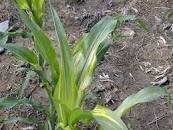AGRONOMICSUPPORT
YOU CAN TAKETO THE FIELD
Advantage of Zinc to Maximize Yields
As I talk to farmers this fall, Top producers often ask how they can get their corn yields to the next level. When other variables are already taken care of (like hybrid selection, proper water & drainage, N-P-K, and disease protection), it’s always important to look at the little things that can limit crop growth. Little things like zinc, which is known to limit high yields when not in adequate amounts.1 Even still, many corn growers overlook the importance of providing zinc in their typical farming practice.
 A small amount of zinc goes a long way to prevent the white or light-yellow longitudinal bands growers see in early season corn development. To put “a small amount of zinc” into perspective, the recommended rate of added zinc on a soil low in available zinc is 1-2 pounds per acre (banded)2. Thus, it doesn’t take a lot of zinc to make a difference in corn yields. Even good soils with adequate zinc levels can be hampered due to the environment. For example, cold and wet soils in early spring is when we typically see the symptoms of deficiency. A slow growing root system is unable to supply the upper portions of the plant with enough zinc to ensure optimum growth. Unless the soil is extremely low on zinc, the plant will eventually “grow out of it” with warmer temperatures and increasing microbial activity. However, the damage is done according to the International Plant Nutrition Institute. Therefore, consider “subsidizing” the temporary zinc short with a short-term solution.
A small amount of zinc goes a long way to prevent the white or light-yellow longitudinal bands growers see in early season corn development. To put “a small amount of zinc” into perspective, the recommended rate of added zinc on a soil low in available zinc is 1-2 pounds per acre (banded)2. Thus, it doesn’t take a lot of zinc to make a difference in corn yields. Even good soils with adequate zinc levels can be hampered due to the environment. For example, cold and wet soils in early spring is when we typically see the symptoms of deficiency. A slow growing root system is unable to supply the upper portions of the plant with enough zinc to ensure optimum growth. Unless the soil is extremely low on zinc, the plant will eventually “grow out of it” with warmer temperatures and increasing microbial activity. However, the damage is done according to the International Plant Nutrition Institute. Therefore, consider “subsidizing” the temporary zinc short with a short-term solution. One state-of-the-art way to provide zinc is via a seed treatment which surrounds the early seedling with just enough zinc until natural release from the soil occurs. Other sources of zinc don’t always fit every operation’s demand of high-speed planting. For example, starter fertilizers with a micro package may provide more available zinc, but added pumps, delivery tanks and the corrosion of equipment are not practical for many operations.
Zinc is an important cation absorbed via corn roots and helps with synthesis of tryptophan, a component of some proteins and a compound needed for the production of growth hormones. A reduction of growth hormones results in a shortening of internodes and smaller than normal leaves.3
Zinc is not an easy nutrient to “add” to seed treatments, which may explain why it’s not available from most seed companies. AgReliant Genetics Corporate Product and Development Manager Fred Sinclair knows the struggles of getting the recipe just right. “We’ve recognized the value of zinc in corn for a long time, but until recently we were unable to get the correct ingredients for adhesion to the seed and flow through the planter. We now have the proper proprietary blends of fungicides, insecticides, nematicide and nutritional components that make this seed treatment ready for market.” says Sinclair.
Five years of research conducted by AgReliant Genetics has revealed a 3.7-bushel average advantage to this new seed treatment with zinc called AgriShield® MAX. LG Seeds is already making the AgriShield® MAX seed treatment a part of its portfolio. According to LG Seeds’ Product & Agronomy Services Manager Logan Vaughn, “The results we saw in 2018 convinced us that our customers were ready for an advantage that provided both zinc nutrition and nematode protection. In 2018, 50 trials revealed the zinc provided a 5.5 bushel per acre bump without having to mess with starter fertilizer on the planter.” Vaughn noted that zinc seed treatment alone cannot replace other benefits of starter such as phosphorus, but that the seed treatment of zinc provides a higher level of yield opportunity than without.
A multitude of field situations would warrant the need for zinc. Local LG Seeds agronomists see opportunity especially for hog producers with excessively high phosphorus which ties up zinc, sandy soils that tend to be inherently low in zinc, fields with low pH <5.5 or excessively high >7.0, and aggressive corn growers wanting to plant early while soils are cool.
Zinc Factoids:
- One of the first micronutrients recognized as “essential”.
- Of all essential micronutrients, Zn removal from the soil is the highest. A corn crop yielding 300 bpa removes .30 of a pound Zn per acre.
- One of the most common nutrients limiting yields. Although required in small amounts, high yields are impossible without it.
- Corn, along with sorghum and sweet corn, are considered “most-responsive” to Zn, whereas soybeans and alfalfa would be “medium responders”.
For more information you can find your local LG Seeds team here.
Sources:
1Soil Fertility Manual by IPNI, ch. 7 p.11.
2Soil Fertility and Fertilizers, 7th Edition, Havlin, Beaton, Tisdale & Nelson p. 262
3Soil Fertility and Fertilizers, 7th Edition, Havlin, Beaton, Tisdale & Nelson p. 256
Download a copy of this technical bulletin here: Advantage of Zinc to Maximize Yields






Technical Team Agronomist